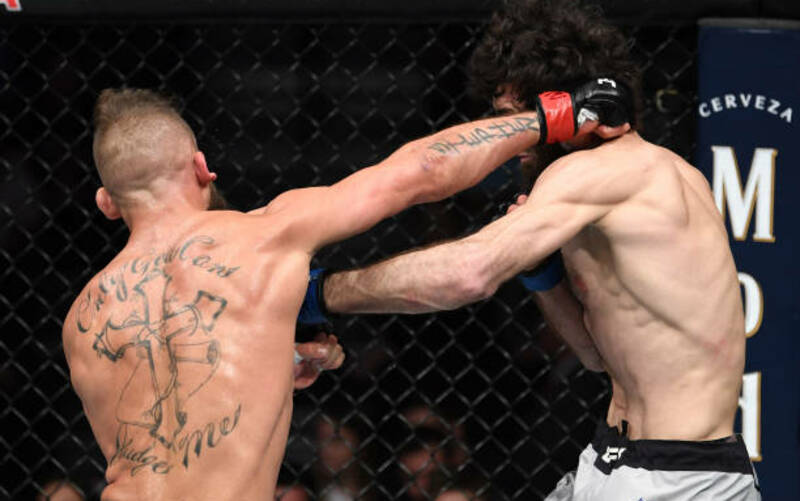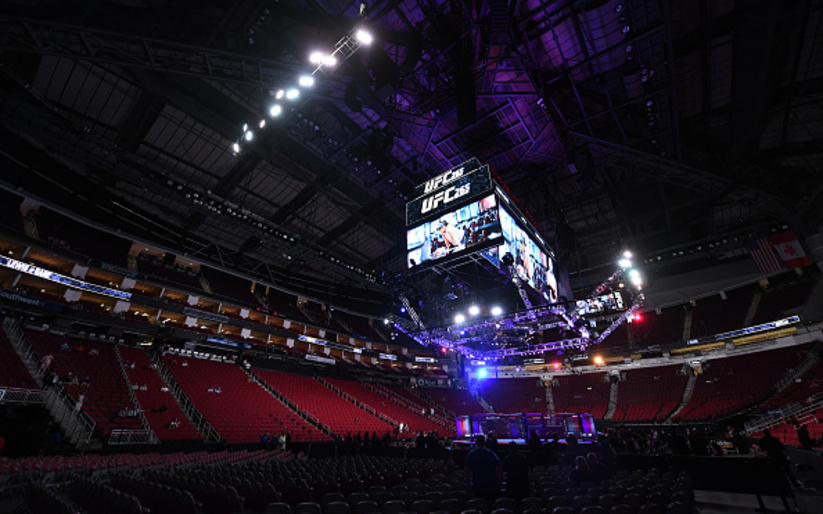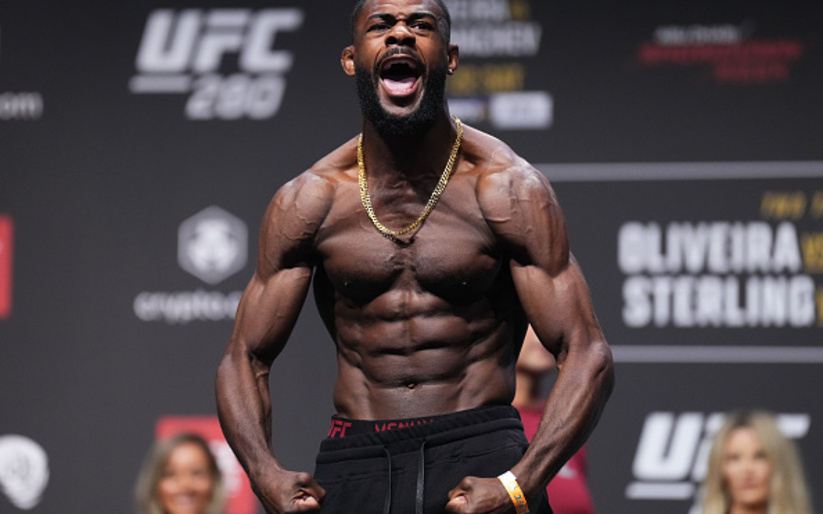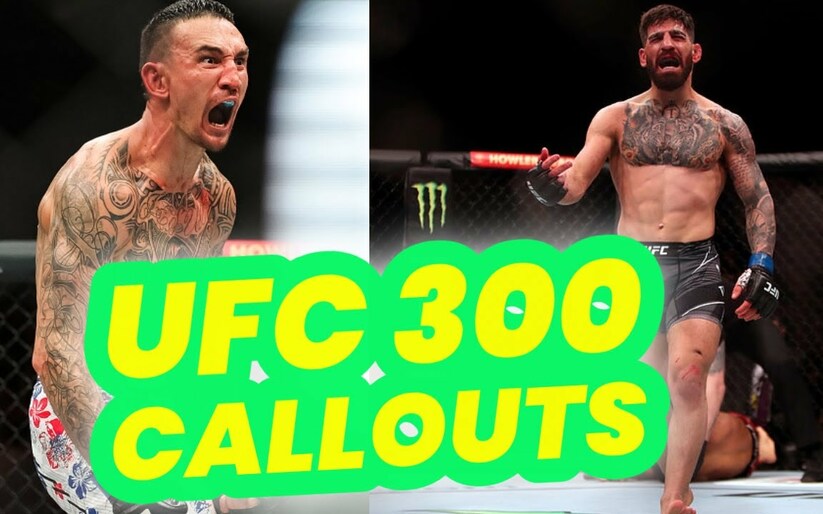In my first article about #6 ranked featherweight contender Zabit Magomedsharipov, I wrote about the technical flaws in his standup and some in-fight traits that could be limiting to the Russian’s success down the line. Since then, Magomedsharipov netted a unanimous decision victory over perennial gatekeeper Jeremy Stephens. Many of the same traits surfaced against ‘Lil Heathen,’ including good awareness in the cage, his left hand carrying most of his offense, and a tendency to fade late.
Today, I will be continuing my examination of the mercurial featherweight, mainly focusing on his most recent performance against Stephens to determine how he has developed since joining the UFC.
Zabit Magomedsharipov Evaluation
Right-Handed Inertia
It doesn’t take much tape study to conclude that Magomedsharipov is a lead-hand dominant fighter. Although, perhaps it is more accurate to call him a left-hand dominant fighter. His counter left hook is still his most polished punch, and he’s getting better at disguising it as a counter.

>Zabit switches from orthodox to southpaw back to orthodox. While Stephens is pressuring, Zabit’s left hand becomes his lead. This opens up the counter left hook.
Recent outings have revealed a stronger jab. When Zabit opts for a southpaw stance, his straight left does most of the heavy lifting. Consequently, Zabit doesn’t appear to have much of a right hand at all. Magomedsharipov almost exclusively uses his right hand for parrying, hand fighting, and stiff-arming when standing southpaw.

>Standing southpaw, Zabit paws at Stephens’ lead left hand before taking a long outside angle to Stephens’ lead foot and slinging a straight left to the body before attempting to stiff-arm back out.
Zabit is not a combination puncher, which makes his lack of a right hand more damning when opponents manage to corral him into the fence. The most offensive attack Zabit used his right hand for against Stephens was attempting spinning back fists, which rarely landed. Allegedly, Zabit broke his right hand against Kyle Bochniak while in the locker room before the fight, but this is a trend that has carried over two fights beyond that specific bout.

>On the regional scene, Zabit showed off a more polishing right hand as well as more willing combination punching. These types of exchanges have seemingly disappeared out of the Russian in recent years.

>Here is an example of Zabit’s lack of craft getting exposed. Stephens corrals Zabit along the fence, and throws a lead hand uppercut. Zabit posts his right arm across Stephens’ body, parries the punch, and torques his body into a counter left hook. As Zabit is attempting to angle out to his left, Stephens nails him with an overhand right that he sneaks over the left shoulder of Zabit.
Pocket Problems
Like many tall fighters, Zabit has learned to utilize his length to mitigate exchanges in the pocket. That’s not to say tall fighters can’t learn to be adept in pocket exchanges, but when fighters with shorter frames manage to get inside of a lengthy outfighter, there is quite a bit of body waiting to be hit. Renato Moicano learned the hard way that allowing a shorter, more adept pocket fighter into trapping range meant that his body, legs, and head were all ready-made targets for the screamingly fast Jose Aldo. Zabit recognizes this limitation of his frame, and has built his technical game around it.

>Much of Zabit’s kicking offense is of the linear variety to maintain space between him and his opponent.

>When Stephens tries to bull into the pocket, Zabit backsteps and stiff-arms Stephens away. When the pocket exchange begins, Zabit crashes into the clinch a left straight before pushing Stephens out and creating space.

>Zabit leads with an outside low kick. Stephens attempts to counter with a wild 2-3. As Stephens is throwing, Zabit tries to post on Stephens’ shoulders while rolling with the shots and sliding into the clinch. Both punches are smothered and Zabit pushes out to create space again.
Something that legitimately impressed me about Zabit’s performance against Stephens was his ring craft. I noted in my first article about Zabit that his awareness along the fence is quite good, and he remained astute against the power puncher. Stephens has a tendency to push forward against his opponents recklessly, and Zabit did a nice job of keeping his exits off the cage open, angling off as Stephens committed to throwing.

>Zabit feints both directions, moving right just as Stephens commits to a spinning backfist before opening up the exit to the left. To his credit, Zabit is consistent about breaking his stance along the fence to shuffle from left to right.
Jeremy Stephens is nobody’s idea of a particularly deep pocket boxer, but he is crafty enough that when he committed to varying his punch entries, he was able to catch Zabit and avoid his counters.

>Stephens throws a lead left hook to the body and levers off it with a left hook to the head. Magomedsharipov attempts to duck off the first punch, and gets clocked with the second. Stephens slides inside of Zabit’s left hook counter.
A Wrestler At Heart
When all else fails for Magomedsharipov on the feet, his wrestling and grappling takes priority. In many ways, Zabit is more of a grappler than a striker at his core, in which his wiry frame and his leverage in the clinch can be put to great use. As a chain wrestler and a top position player, Zabit is genuinely impressive to watch.

>Zabit shoots for a head-outside single and runs the pipe to secure it. When Stephens posts on the mat with his left arm, Zabit attempts to step his left leg over Stephens’ hip to secure mount, but Stephens shrimps his hips. As Stephens works his way back to his feet, Zabit (holding the single leg) transitions to a double leg and secures a takedown.

>Here, we see Zabit’s ability to hit counter takedowns off kicks, as well as setting up his own entries.

>One of Zabit’s favorite entries is hopping his lead leg outside of an opponent’s lead leg, tripping it, and pushing their head over their feet.
If there is one area of the Russian’s technical game that is remarkable, it’s his transitional ability in wrestling and grappling exchanges.

>With a double waist lock along the fence, Zabit kicks out Moraes’ right leg, causing his base to give out and Moraes to stumble off the fence. Zabit transitions from a belly-to-back suplex mat return right into sinking both hooks, pinching his left knee into the ribs of Moraes and locking his left foot behind the calf, securing his position.
Zabit’s top control and basic takedowns are strong, but he is most effective from the double waist lock position. He doesn’t always need to convert this position into full takedowns, since he is able to hold the double waist lock for minutes at a time.

>While sitting in three-quarter mount, Zabit controls Stephens’ posting right arm with an over-under grip similar to the seat belt. He has two-on-one grips on Stephens’ right arm, and with his left hand, he drags Stephens’ right arm under his body before yanking it under Stephens’ torso with his right hand. This takes away Stephens’ base, breaking him down, as well as trapping the arm. With Zabit’s right arm holding Stephens’ right arm under Stephens’ body, Magomedsharipov uses his free hand to punch.
Zabit is very obviously more comfortable as a mat wrestler and scrambler than as a striker. The mat has been something of a safety net for the Russian. When Zabit is running out of ideas on the feet or if his opponent is giving him more difficulty than he knows how to deal with (as Davis and Bochniak both did), the wrestling has always been there to bail Zabit out. This begs the question: what if the takedowns aren’t there?
Conclusion
For such a skilled and well-rounded fighter, the most frustrating thing about Zabit is his lack of depth. He is not an especially layered striker, and this hasn’t really been a problem for him at the low-to-mid levels of competition, but I suspect that these issues will rear their head sooner, rather than later. Zabit’s ostensible power from his regional days seems to have disappeared and his defense tends to fall apart in layers. Fundamentally, Zabit doesn’t build his offense on the feet, and that wouldn’t be such a problem if the upper echelon of featherweight weren’t rife with contenders whose technical games expand as the rounds progress. Despite an undefeated UFC record, Zabit Magomedsharipov has many questions left to answer before he can justifiably be considered elite.
Main Photo
Embed from Getty Images




Worth noting it’s come out that Zabit broke his right hand last year. A lot of his weak right hand offence likely still stems from that injury.